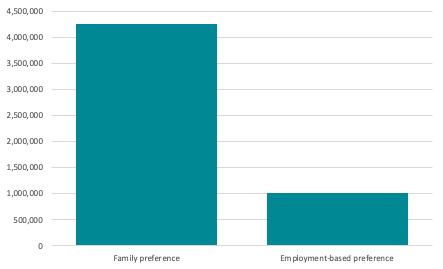The legal immigration provisions in the House version of reconciliation help families and a diverse population of immigrant applicants
As the Senate debates whether to include provisions addressing the immigrant backlog in the Build Back Better Act, some lawmakers have raised concerns that they are too narrow to be worth considering on their own (that is, if not included in a larger package addressing undocumented immigrants). This comes from a perception that they would primarily be a handout to businesses — or, to the extent they would help immigrants, only a narrow group (predominantly Indians). But in truth, the House provisions would represent much-needed relief to a diverse group of immigrants and their families.
Myth #1: 60002 and 60003 are a business handout
Addressing both family and employment-based green card backlogs is good for businesses and the economy. Still, the primary beneficiaries are immigrants themselves. The family-based backlog is much larger than the employment-based backlog (see table below). Addressing it means reunifying families kept apart by our restrictive immigration laws. Even within the employment-based category, reducing the backlogs would be putting families first; while immigrants are stuck in the backlog, the status of the entire family is dependent on the principal immigrant’s job and children are at risk of aging out of derivative status. Employment-based green cards also give migrants more rights relative to their employer, allowing them to leave jobs and ensuring the work authorization of spouses and other family members.
Approved immigrants on the waiting lists

Both recapture and advanced adjustment of status would offer relief to immigrants in both employment and family categories. As we can see in the table below, the recapture provisions would about evenly provide green cards to both categories. Advanced adjustment of status would also help people in both categories. Fees for immigrants in the family-based line would be lower and there would also be more eligible applicants. While a much lower ratio of family-based immigrants adjust status (most are new arrivals), the opportunity for advanced adjustment would likely make many more family-based immigrants move here on temporary visas like the V visas before receiving green cards.
Recaptured green cards under House version of reconciliation

Myth #2: 60002 and 60003 would only help a narrow special interest
Indian-American and Chinese-American immigrants are the victims of cruel irony in immigration politics: they are disproportionately harmed by the per-country caps but, because the burden of the policy so disproportionately falls on them, reforming the per-country limits is seen as helping a narrow special interest. This unfortunate dynamic is perversely affecting reconciliation 60002 and 60003, where a misperception exists that the provisions would narrowly only help Indians.
The first thing to note is that nothing being considered changes the per-country caps. So, as far as recapture is concerned, only 7 percent of recaptured visas can go to Indians. Whatever one’s opinions on the per-country caps, they will remain in place and ensure diversity for recipients of recaptured green cards.
Advanced adjustment of status is a somewhat different story because it includes cap exemptions. Nevertheless, it will also help a diverse group of immigrants from many countries of origin. On the employment-based side, most of the beneficiaries will indeed be Indians and Chinese (who we must remember have been harmed most by the existing caps). Still, the employment-based backlog is much smaller than the family-based backlog, representing only about a fourth.
Within the family-based backlog, where most immigrants are waiting, more immigrants are from North America than from Asia.
Family preference visa waiting list with State Department by region of origin, as of November 1, 2020

Indians make up only about 8 percent of those stuck in the family-based line. The largest group in the family-based backlog are not Indians, but Mexicans, comprising about 31 percent, followed by Filipinos at 8 percent. Other leading countries of origin for eligible immigrants include Vietnam (at 5 percent), the Dominican Republic (5 percent), Haiti (3 percent), and Cuba (2 percent).
Family preference visa waiting list with State Department by country of origin, as of November 1, 2020

These two myths about the House provisions on legal immigration reform may arise from the fact that Indian employment-based immigrants are among the most visible group who would benefit by virtue of their being more likely to be present in the country. Family-based immigrants, by contrast, are mostly not already present in the United States and so more likely to be invisible.
The House provisions stand to be the biggest improvement to our immigration system in thirty years. It will be a tragedy if we forfeit the opportunity because of myths about who it would help.
Photo Credit: Viktoriia Miroshnikova via iStock